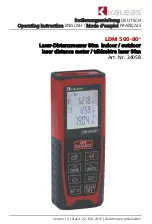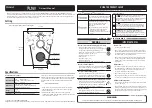
version H28986 2014
Potential Difference as Energy per Unit Charge
Apparatus:
Joulemeter/wattmeter
Variable resistor/rheostat 0 to 10Ω, 1A rating Meters
1A d.c. and 5V d.c.
Digital stopclock
Source of smooth d.c. variable 0 to 6V d.c. e.g. 25V Variable OR Beaver Power Supply.
Procedure:
Adjust the supply voltage and the load resistance, R, to give a current, I, of 1A at a p.d. of 1V.
Measure the energy, W, dissipated in a convenient time, t. Repeat the procedure for other values
of p.d. each time adjusting the load resistance to give a current of 1A.
Note:
1.
The experiment is intended as a simple illustration of the relationship between p.d., charge
and energy. It should not be taken to establish this relationship.
2.
The voltmeter is connected in the load circuit to avoid measurement of the potential drop
across the joulemeter.
Further applications:
The circuit can also be used to demonstrate
1.
W = I V t
2.
P = I V
3.
P = I2R
Effective Values of an alternating current.
Apparatus:
Joulemeter/wattmeter
10V d.c. meter instead of 1mA d.c. meter.
Resistor, 10kΩ
Oscilloscope
10V d.c. meter
10V a.c. meter
Source of smoothed d.c. 9V 1mA, e.g. PP3 battery or variable, smoothed power supply Source of
a.c. and unsmoothed d.c. (full wave rectified) 0 to 12V 1mA
Procedure:
Set the oscilloscope inpu
t to d.c. (or ‘direct’) and the time base to 10ms.
Connect the d.c. meter, switch to the smooth d.c. source and measure the applied p.d. with both
the meter and the oscilloscope. Record the power, P, dissipated in the load. Connect the a.c.
meter, switch to the a.c. source and adjust the applied p.d. to give the same power dissipation.
Measure the effective p.d. on the meter and the peak p.d. on the oscilloscope. Repeat the
procedure with the unsmoothed (full wave rectified) d.c. source, using the d.c. meter to measure
the average p.d. and the oscilloscope to measure the peak p.d.
The effective value of an alternating current is the value of that steady current which would
dissipate energy at the same rate as the alternating current. In resistive circuits:
effective current
I
EFF
= root mean square current, I
RMS
similarly
V
EFF
= V
RMS





























